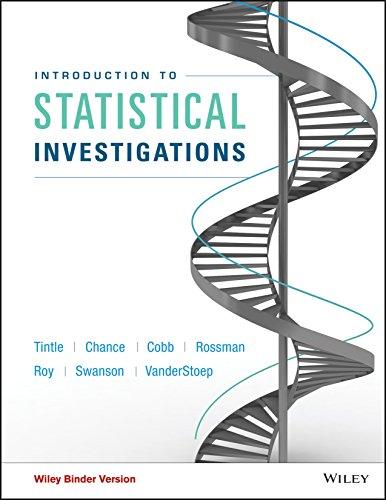Question
A researcher uses data from 162 U.S. cities in 1900 to investigate the link between infant mortality and toxic lead in drinking water. Her data
A researcher uses data from 162 U.S. cities in 1900 to investigate the link between infant mortality and toxic lead in drinking water. Her data set contains the following variables: infrate (infant mortality rate), lead (a dummy variable equal to 1 if the city had lead pipes and 0 otherwise) and ph (water pH, where pH is a measure of acidity: in particular, lower pH denotes higher acidity). The following is her R output.
- lead_mortality<-read.csv("lead_mortality.csv")
- modi<-Im(formula=infrate~lead+ph+lead:ph, data=lead_mortality)
- summary (mod1)
Call:
Im(formula = infrate ~ lead + ph + lead:ph, data = lead_mortality)
Residuals:
Min
10
Median
30
Max
-0.27645 -0.08816 0.00134 0.07668 0.36350
Coefficients:
Estimate Std. Error t value Pr(>|t|)
(Intercept) 0.81337
0.17696
4.596 8.75e-06
lead
0.59436
0.22733
2.615
0.0098 **
ph
-0.06164 0.02456 -2.510
0.0131
lead: ph
-0.07394 0.03113
-2.375
0.0187 *
Signif. codes: 0 ****' 0.001 ***' 0.01 **' 0.05 .' 0.1 * ' 1
Residual standard error: 0.1279 on 158 degrees of freedom
Multiple R-squared: 0.2694,
Adjusted R-squared: 0.2556
F-statistic: 19.42 on 3 and 158 DF, -value: 9.006-11
> bptest (mod1) studentized Breusch-Pagan test
data: mod1
BP = 10.013, df = 3, p-value = 0.01845
> ( coeftest (modi, vcov = VCOVHC) )
t test of coefficients:
Estimate Std. Error t value Pr(>|t|)
(Intercept) 0.813374
0.152818 5.3225 3.457e-07 #**
lead
0.594364
0.219825 2.7038 0.007606 **
ph
-0.061640 0.021637 -2.8489 0.004972 **
lead: ph
-0.073944 0.029850 -2.4772 0.014295 *
Signif. codes: 0 **#*' 0.001 **#' 0.01 **' 0.05 '.' 0
(a) Does her test detect heteroskedasticity at 5% level of significance?
(b) Consider two linear regressions: a regression of infrate on ph for cities with lead pipes and a regression of infrate on ph for cities without lead pipes
(i) Are the intercepts of the two regressions equal at 5% level of significance? What is the corresponding t-statistic?
(ii) Are the slopes of the two regressions equal at 5% level of significance? What is the corresponding t-statistic?
(c) Find the predicted difference in infrate between a city with lead pipes and a city without lead pipes if the water in both cities has a pH of 7.
Step by Step Solution
There are 3 Steps involved in it
Step: 1
Answer a To detect heteroskedasticity at the 5 level of significance we can use the BreuschPagan test The R output shows the following bptest mod1 stu...
Get Instant Access to Expert-Tailored Solutions
See step-by-step solutions with expert insights and AI powered tools for academic success
Step: 2

Step: 3

Ace Your Homework with AI
Get the answers you need in no time with our AI-driven, step-by-step assistance
Get Started


